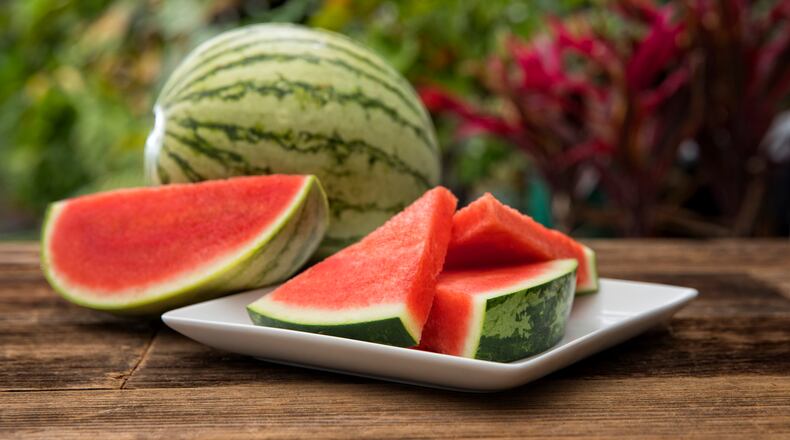Its popularity in the hot, desert regions can be attributed to the high amount of water that watermelon contains.
From Africa, watermelon crossed into Europe where it grew successfully in the warmer parts of the Mediterranean. By the 7th century it reached India and from there China which saw its first watermelons in the 10th century.
Today, China is the world’s largest producer of watermelons. The rest of Europe did not start growing watermelons until the 17th century when they were widely accepted as a minor garden crop.
Watermelons were brought to the Americas by European colonists. The first ones were grown in Florida in the 16th century. Later in the 17th century, they were grown in Massachusetts, Peru, Brazil, Panama, and many British and Dutch colonies.
Today, watermelons grow on annual vine plants that creep along the ground attaining lengths of 6 to 10 feet. Their leaves form a canopy over the fruits.
Although they can thrive in many kinds of soil, the highest yields and the best watermelons are produced with fertile, well-drained, slightly acidic sandy or silt loam. A long, frost-free season with ample sunlight, warm temperatures, and low humidity is ideal for melons.
With such climatic requirements, it should not be surprising that in the U.S. All but a few varieties are grown only in the south. Florida, Texas, Georgia, and California are the leading domestic producers.
Unripe melons can be ripened in a paper bag at room temperature. Because some melons absorb the odor of other foods even when uncut, they should be wrapped in plastic or a sealed container if kept in the refrigerator for more than a day.
Melons keep well in the refrigerator for up to one week.
RECIPES
Mediterranean Watermelon Salad
Ingredients:
6 cups of torn mixed salad greens
3 cups of 1” cubed watermelon
½ cup sliced onion
1-tablespoon extra-virgin olive oil
1/3 cup crumbled feta cheese
Black pepper
Directions: In a large bowl, mix all ingredients except oil and pepper. Just before serving, toss salad mixture with oil. Garnish with pepper.
Watermelon Cranberry Sauce
Ingredients:
4 cups of fresh cranberries
½-cup sugar
1-teaspoon vanilla extract
1 lemon (juice squeezed from the lemon)
Zest from lemon
½-cup maple syrup
Dash cinnamon
2 cups minced watermelon
Directions:
- Heat cranberries, sugar, vanilla, lemon juice and zest in a 3-quart saucepan over medium low heat until it summers. Simmer gently, stirring occasionally until cranberries are tender, about 15 to 20 minutes.
- Reduce heat to low and add the maple syrup and cinnamon to the pan. Simmer for another few minutes. Remove from heat to rest for 10 minutes. Stir in watermelon and serve warm or chill and serve cold.
Breakfast Six Layer Trifle
Ingredients:
4 cups of minced watermelon
3 cups of fat-free vanilla yogurt
3 cups of fat-free peach yogurt
2 cups low-fat granola
2 cups of crisp rice cereal
2 cups of shredded coconut
Directions:
- Spread the vanilla yogurt over the bottom of a deep glass casserole or trifle dish.
- Layer the remaining ingredients over the vanilla yogurt in even layers.
Watermelon Salsa
Ingredients:
3 cups of chopped watermelon
½ cups chopped green peppers
2 tablespoons lime juice
1 tablespoon chopped cilantro
1 tablespoon chopped green onions
1-2 tablespoons chopped jalapeno peppers
½ teaspoon garlic salt
Directions:
- Combine all the ingredients; mix well.
- Cover and refrigerate for at least one hour before serving.
Interested in free nutrition education lessons from OSU Extension Expanded Food and Nutrition Education Program (EFNEP)? Contact Nancy Lyons at 937-224-9654 or lyons.489@osu.edu.
WATERMELON TRIVIA
- Every part of a watermelon can be eaten
- Watermelon seeds are very nutritious
- Japan is known for growing square watermelons; Farmers will enclose a watermelon in a glass box of square shape as it grows
- Seedless watermelons have been around for about 50 years.
- Ninety-two percent of the watermelon is water
- The biggest watermelon grown was in Sevierville, Tenn. (2013), weighing in at 350.5 pounds
- In China, it is custom that guests offer watermelons to the host as a gift
- July is National Watermelon Month in the U.S.
- By weight, watermelon is the most consumed melon in the U.S. followed by cantaloupe and honeydew
- Early explorers used watermelons as canteens
- The U.S. ranks fifth in worldwide production of watermelon
- There are more than 1200 varieties of watermelon that come in various weights, shapes, sizes, and red, orange, yellow, and white in color
About the Author
